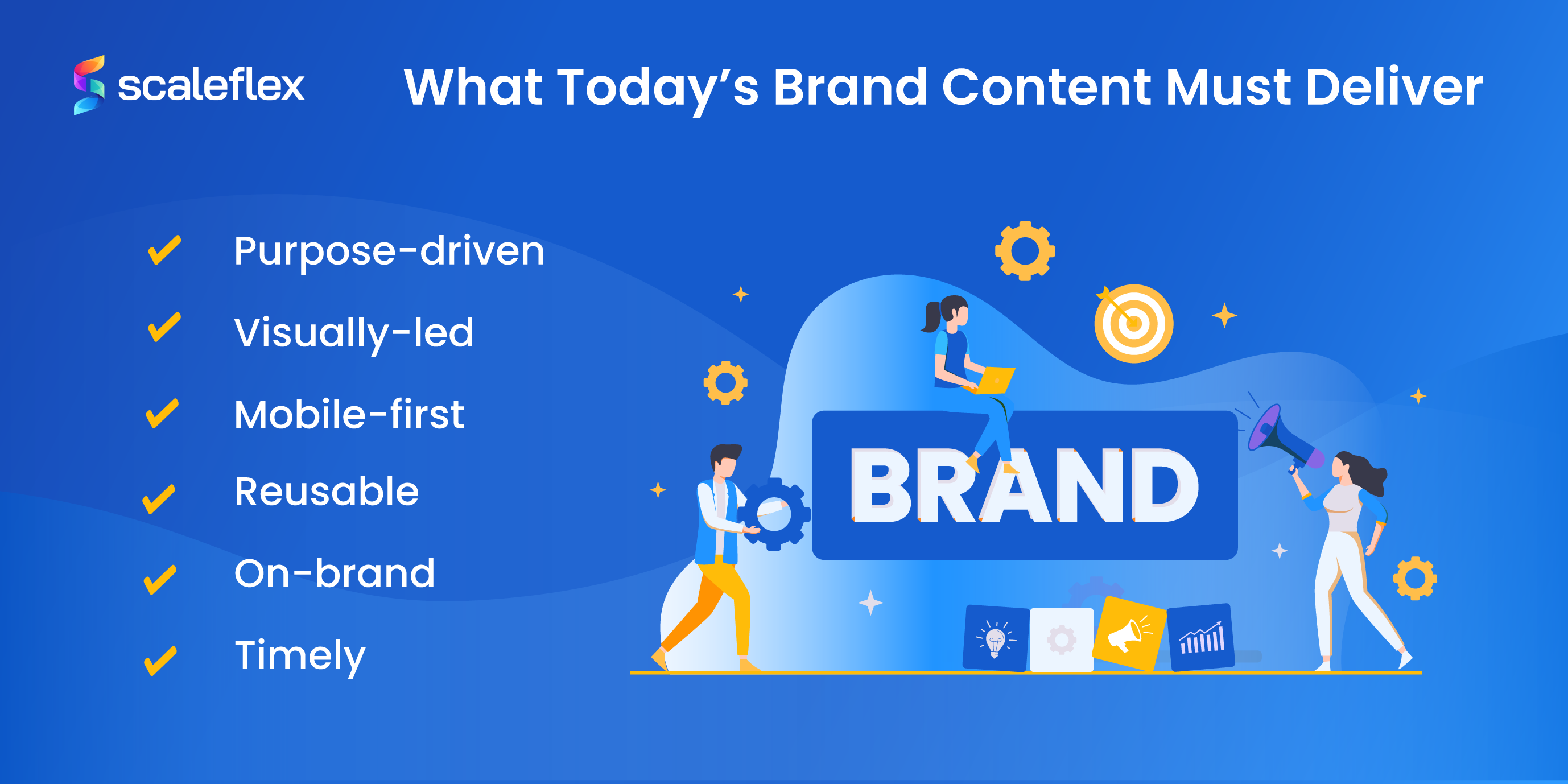How To Build A Smarter Brand Content Strategy In The Visual Era
We know that they sound similar, but “brand content” and “branded content” are different things, serve different purposes, and confusing them could potentially derail your content strategy. Brand content marketing is the ongoing effort to express a company’s identity, values and vision through useful and engaging material. It’s a kind of permanent layer of communication: blog articles, tutorials, how-to videos, visual guides… content that delivers value above all, and has no direct sales push.
So, what is branded content? It’s a kind of more campaign-centric content. Think, for instance, of a short film that’s been co-produced with a media outlet, or a limited influencer series. It often has the goal of generating emotional impact, memorability or cultural relevance. We could say that branded content is storytelling with flair, while brand content is storytelling with value and structure.
The difference is an important one, because brand content is building long-term trust and organic reach, filling your SEO pipeline, reaching potential customers and converting interested buyers. Branded content is powerful, episodic, and serves to place you in consumer’s top-of-mind. It’s a complement to a consistent brand presence. Both are an important aspect of a well-rounded content strategy, and today, we’re going to focus on the brand content strategy aspect.
What today’s brand content needs to deliver
Our current digital environment is very demanding, and more than visibility, what today’s audiences really require is relevance. They are scrolling fast, searching for personalization, judging value in mere seconds. In such a context, a brand’s obligation is more than to just inform; it must connect and add value to the user.
Your messages must not only look good, but also serve a clear purpose. Be it a tutorial video, social media carousel, e-commerce landing page or other, each piece of content must answer a question, solve a problem or reflect your brand’s stance. Valuable content attracts and keeps attention.
As we know, users gravitate towards imagery before they start processing the text, which is why your brand content marketing has to be visually led, mobile-first, and easily reused across formats. Delivering this at scale is not easy. Teams have to move fast while they strive to maintain their brand’s integrity across languages, regions and platforms. There should be no room for error, ideally, as content has to be timely, on-brand and tailored to the channel.
Creative and marketing teams stretch themselves thin to accomplish this, and it becomes a particularly arduous task without a structured system to help them manage the growing numbers of visuals. Disconnected folders, scattered workflows and outdated brandbooks slow teams down and can lead to mismatched assets or off-brand publications.
In a nutshell, today, brand content starts the moment you begin to prepare for publication. Consistency, agility and discoverability must be pillars of a successful strategy. A smart content infrastructure can keep creativity flowing without sacrificing orderliness.
Behind the scenes: organizing content for strategy, not chaos

We know that as brand content scales, so does the complexity of managing it. If we don’t have a solid structure, the sheer volume of content could quickly spiral out of control, leading to inefficiencies and missed opportunities. This means that organizing your content is more than a matter of neatness, it’s a strategic move which directly impacts your brand’s ability to function properly.
First and foremost, we have to create a centralized and easily accessible asset library. For this, a DAM for marketing solution can come in handy for teams that are handling large volumes of visual content. The best form of organization will always be the one that works best for your team and helps them become more efficient. A DAM is a good solution as it centralizes everything in a single source of truth, meaning that assets are not just well-organized and stored, but also tagged and easily searchable.
Once your chosen system of organization is up and running, your team can align on naming conventions, version control and access permissions in order to prevent any redundancies, confusion and errors. Being able to find the needed piece of content quickly can make branding work much easier, and simplify repurposing content, adapting visuals or refreshing old assets for seasonal updates. It can also mean increased efficiency across departments, as marketing, design and sales can share, approve and reuse materials quickly and without bottlenecks.
The thing is that when we don’t waste time looking for things, our creativity can flourish. Teams can concentrate on the value they add through brand content creation once they rest assured they’re up to date on the latest guidelines, they can easily retrieve and get inspiration from work they’ve done in the past or they can repurpose campaigns that worked. From organizing content stems a much broader impact, that of a smarter, faster and more impactful brand content strategy.
Visual AI and Brand Portals: the hidden engines behind great brand content
The tools we use behind the scenes matter, and as brand content marketing is becoming increasingly visual and data-driven, the tools that we use behind the scenes are almost as important as the content itself. Putting new, AI-driven technologies to use can help streamline your content management, boost productivity and guarantee brand consistency, which can transform how your brand content is organized and delivered.
New Visual AI technologies use machine learning and image recognition and automatically classify and tag assets according to their content, context and even sentiment! It can identify logos, objects, colors and even emotions within images, rendering content more easily searchable and actionable. It eliminates manual tagging and classification, helping reduce human error and speed up the content discovery process. These AI-enhanced workflows guarantee that the right assets are quickly found and match specific campaigns or customer segments, helping teams save valuable time.
Another new and emerging technology are brand portals that serve to act as a bridge between teams and external partners. These portals propose a customizable, user-friendly interface to share brand assets without getting lost in the chaos of more traditional systems. Delivering campaign materials to all involved or providing press kits to journalists, or even centralizing brand guidelines, a brand portal can really help teams stay on track with their brand content strategy. It can also render rights and permission management simpler, and ensure the right people have access to the right content.
New technologies are helping shape smarter, more agile content ecosystems, where brand content strategies can truly thrive and perform at scale.
From strategy to activation: delivering visual content that performs
Building a brand content strategy happens within a team of creative marketers, but creating a successful one is where the real work happens, as all the theoretical steps must be activated and put into practice. Your brand content mustn't just resonate with the audience, but also perform across different platforms and devices. You must have a sharp understanding of user behavior, and the ability to adapt your content adequately to meet different channels and expectations.
A crucial element for activation is ensuring that the content is optimized for speed as well as performance. Poorly formatted images and slow-loading content can lead to higher bounce rates as well as lower engagement, dragging down your performance. It is essential to optimize your images for different screen sizes, mobile users and diverse web platforms where your products or services may show up. This will help you achieve a smooth user experience, and will have a direct impact on your SEO and conversion rates.
To ensure that content feels relevant for each user, personalization is an essential factor. Be it through dynamic images, tailored messaging or timely updates, to understand audience’s preferences and behaviors will allow brands to propose content that resonates with them, be it based on location, season or their browsing history.
Finally, to ensure that your content remains consistent across channels and platforms is also crucial. If your brand’s visuals align perfectly, you’re reinforcing a cohesive brand identity that will increase and improve customer’s trust.

Conclusion: future proofing your brand content ecosystem
Crafting a smart brand content strategy isn’t about making more content, but about rendering the same amount, more impactful. Tools can help optimize and streamline workflows, guaranteeing consistency, and helping you scale content operations without having to sacrifice quality or relevance.
Brand content creation is constantly evolving, and so are the systems that support it. Having the right technology is important, but so is understanding how to use it strategically. As content is organized, optimized and smartly activated, brands can build better connections with their audience, improving engagement and boosting performance.
What does future proofing your brand content mean today? It means investing in scalable solutions that will enhance your creativity, accelerate time-to-market and help you control your brand’s messaging. Putting certain workflows, habits and technologies in place, you can stay ahead of the curve and continue thriving in today’s visual-first digital ecosystems.





